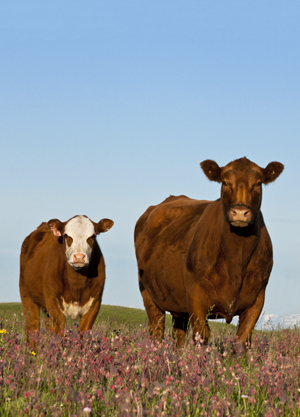Making Dollars out of Sense
Remarque : cette page web n’est actuellement disponible qu’en anglais.
This article written by Dr. Reynold Bergen, BCRC Science Director, originally appeared in the May 2017 issue of Canadian Cattlemen magazine and is reprinted on the BCRC Blog with permission of the publisher.

Aside from price insurance (in provinces where it is available), cow-calf producers can’t do much to control the price they receive for their calves, so managing input costs is often the biggest opportunity to improve profitability. The Western Beef Development Center has found that annual production costs differ by at least $100 per cow between the 25% lowest cost producers and the average producer. A 2015 Quebec report found a $79 per cow per year difference between a group of cow-calf operations with the highest margin and the average. In PEI, annual cost of production between the 10% highest and lowest cost operations differed by $660 per cow.
During BSE, drastic times called for drastic measures, and input costs were often cut as much as possible. But this may not be the best strategy for today’s more normal conditions. If it’s not done carefully, reducing inputs can harm profitability.
Feed is responsible for the biggest costs, including land, fuel, seed, and fertilizer to establish, grow, manage and graze or harvest pasture or winter feed. Investments to increase forage and feed yield and/or quality, through appropriate pasture management (e.g. intensive or rotational grazing), agronomy (e.g. crop and variety selection, seeding dates, fertilization, weed control practices and harvest dates) can help reduce land base requirements by greatly increasing carrying capacity. Growing more forage per acre means that fewer acres are needed for each cow, or that more cow-calf pairs can be raised on the same land base.
Using feed and forage resources as efficiently as possible through extended grazing (where appropriate), feed testing and appropriate supplementation are other examples where increased costs in one area are offset by lower overall costs. Feed requirements are higher in extended grazing systems, partly because cows need more feed when wintered on pasture than when they are fed in confinement, but overall cost per cow per day ends up lower in many cases due to labor, equipment and fuel savings. But even here, feed cost savings with poorly managed extended winter grazing can result in lower overall profitability if the cow’s nutritional requirements are not met. Reducing feed costs needs to be balanced with ensuring that the cow still receives the nutrition she needs to get through the winter in good body condition, give birth to a live, healthy calf, provide it with high quality colostrum, and wean it at an acceptable weight, all while rebreeding within 60 days of calving to maintain a 365 day calving interval. If standing forage, swath or bale quality is lower than assumed and cows lose body condition during the winter, they may enter the calving season in thin condition, have more trouble calving, rebreed later, and wean lighter calves next year. This is a particular concern with first calf heifers and young cows that are still growing while they are pregnant and raising their calves, so their nutritional requirements are particularly high. Failing to meet the cows nutritional requirements will greatly increase the risk that they will rebreed late or not at all, and increase the chances that they will be culled long before the calves they weaned have covered their purchase or development costs. Spending money on a feed test, and using that information to appropriately supplement protein, energy and minerals will help avoid that risk.
On top of this, there are genetic differences between animals; some cows can winter on less feed than others while still maintaining body condition and rebreeding successfully. Sometimes these may be smaller cows that wean smaller calves that may be discounted in the marketplace. But there are some cattle that really do digest and metabolize their feed more efficiently than others. This means that two cows of the same breed and size may maintain their body weight and condition equally well, and raise and wean similarly-sized calves year after year, but with one needing considerably more feed per year than the other. In time, genetic tools may become refined enough to accurately identify these differences in commercial cows.
You can hear more about this at the Bov-Innovation session at the 2017 Canadian Beef Industry Conference in Calgary (August 15-17). Bov-Innovation will again feature talks from researchers, paired with beef producers, presenting some basics as well as the latest science-based recommendations and practical production tips on a range of topics. Presenters will include Matt Spangler (University of Nebraska-Lincoln) speaking about genomic selection tools for commercial herds. John McKinnon (University of Saskatchewan) will talk about economical ways to deal with mycotoxin contaminated feed grain. The Western Beef Development Centre’s Kathy Larson will discuss economic considerations when selecting replacement heifers alongside a speaker (to be announced) who will talk about the critical animal health and nutritional management considerations essential to achieving a 365-day calving interval. We hope to see you there!
Click here to subscribe to the BCRC Blog and receive email notifications when new content is posted.
The sharing or reprinting of BCRC Blog articles is typically welcome and encouraged, however this article requires permission of the original publisher.
We welcome your questions, comments and suggestions. Contact us directly or generate public discussion by posting your thoughts below.
